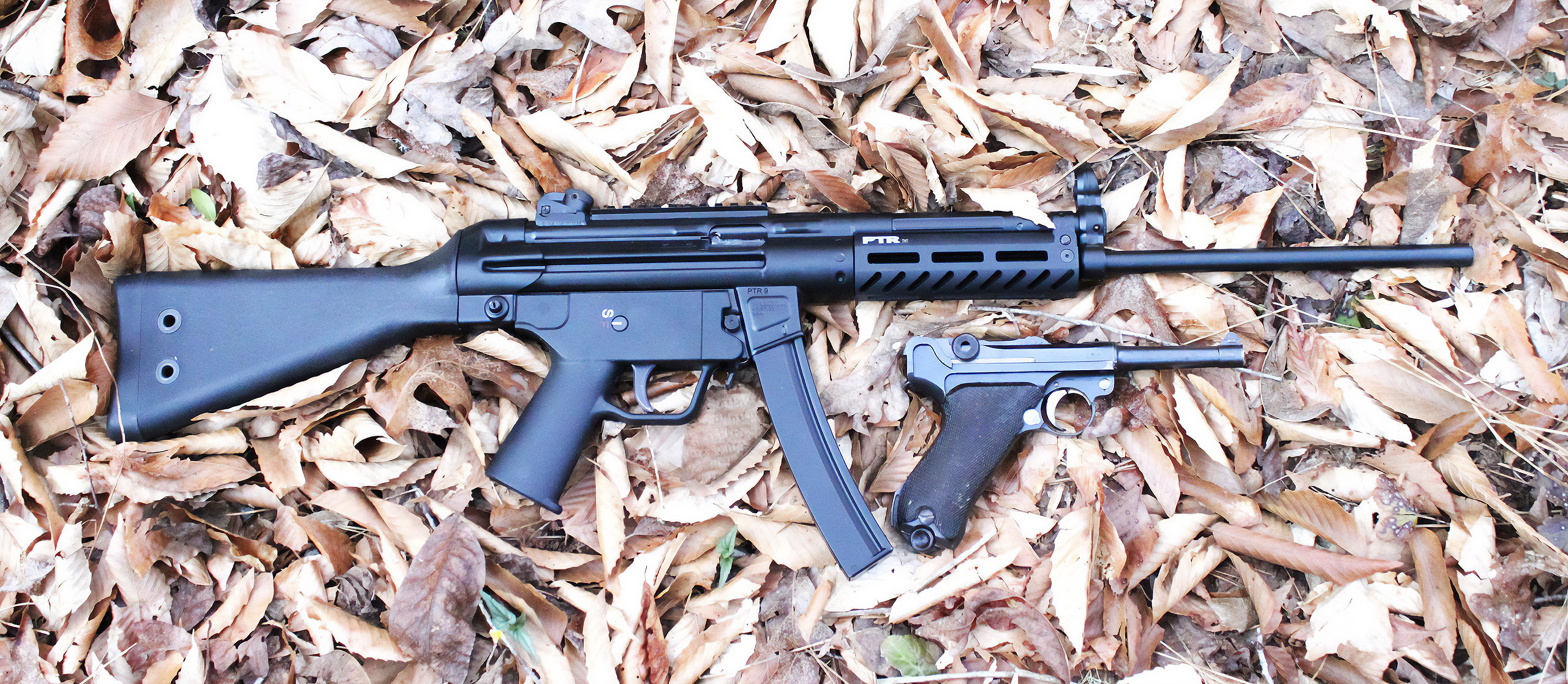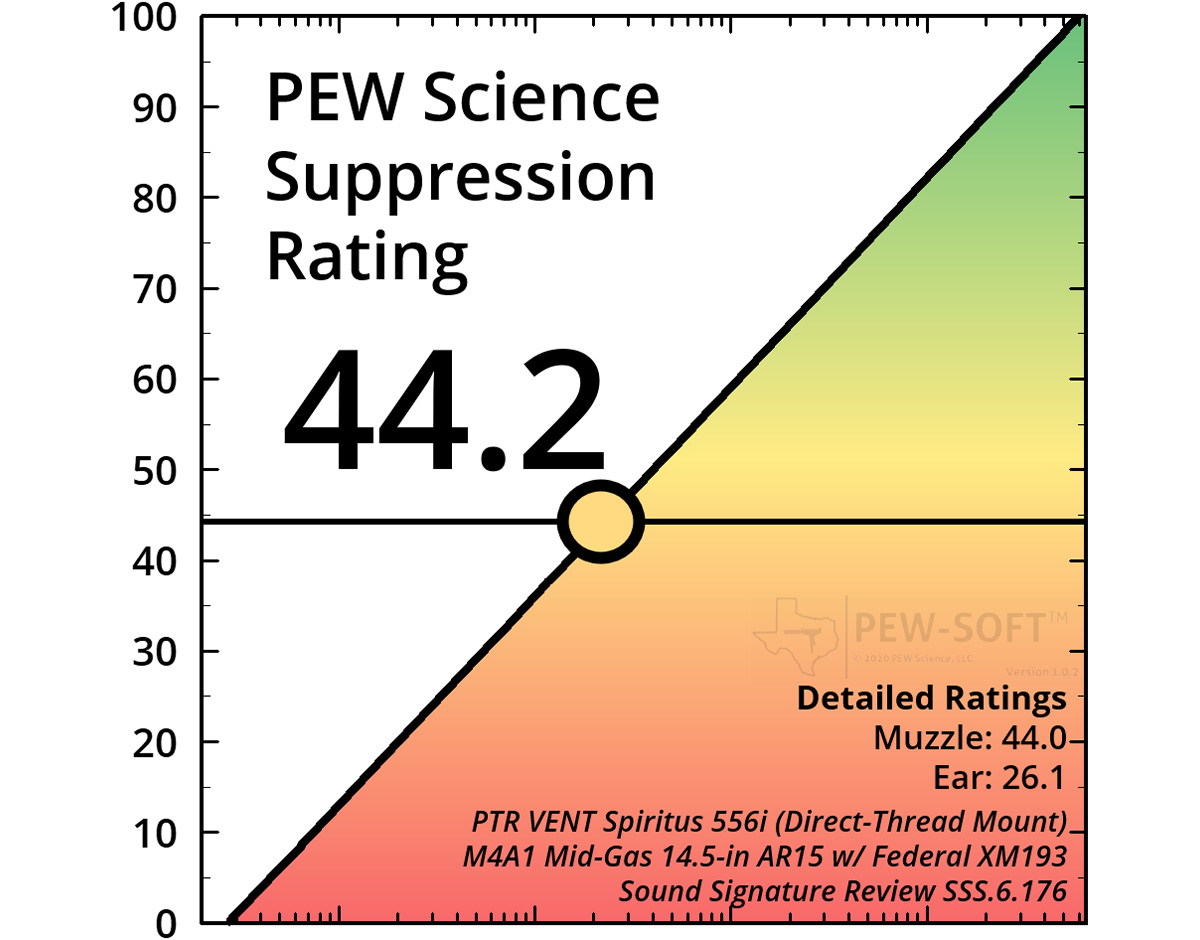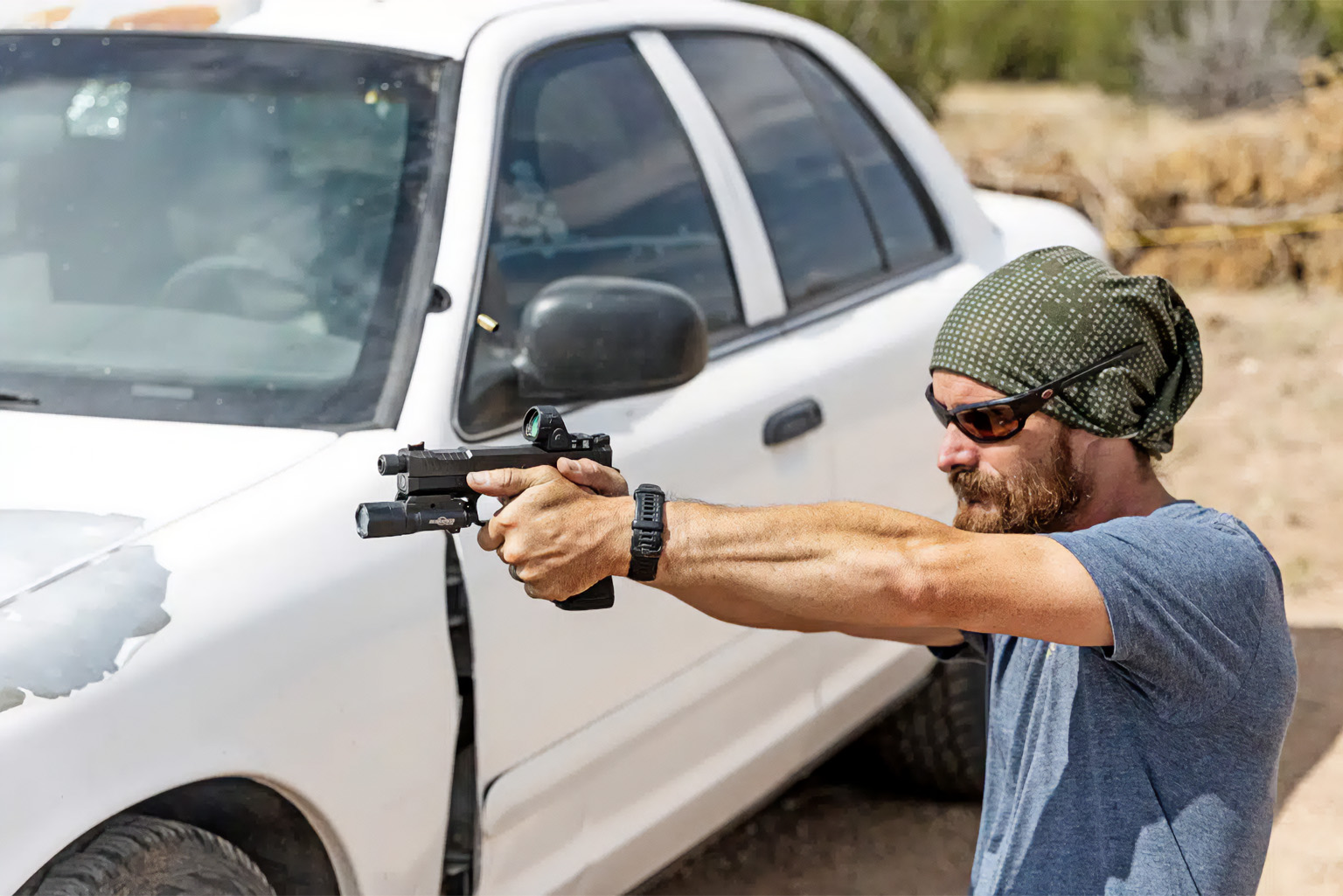Those of you who are familiar with my writing know that I like pistol caliber carbines as these are the best all round rifles for the subsistence hunter, able to take small game without ruining a lot of meat yet still capable of taking big game.
Therefore I was happy when PTR sent one of their 9R rifles to Reeves Ace Hardware in Clayton, Georgia for me to pick up and review. This is a semi-auto carbine version of the 9mm H&K MP5 SMG. While the 9mm Luger cartridge is a bit on the light side for big game I do remember two grizzly bears killed with the P08 Luger pistol so it will work in a pinch although I would prefer a .45 for these giants.
The 9mm is more toward the .32-20 size, excellent for small and medium game and still able to deliver the goods on the bigger stuff if need be. Remember that the whitetail deer does not weigh more than humans and one has only to look at the over 100-year war record of the 9mm Luger cartridge to see its effectiveness on people. Also, a subsistence hunter will see and kill far more small and medium game than he will big game for there are simply lots more of them.

Left side view showing the simple controls, receiver, rear sight and charging bolt.
This is a lovely little fast handling carbine that will be familiar to users of the H&K MP5 SMG. It weighs a mere 6 pounds 10 ounces and like all German design military weapons it is both lively and steady to hold on target. This is no small feat with a lightweight gun.
The overall length is 34 3/8 inches. This is because of the NFA requirements for a longer barrel than the MP5 but this also puts the muzzle blast further from your ears and makes the little carbine more pleasant to fire. The action is the familiar roller locked action of the great German G3 rifle scaled down where need be for the smaller 9mm cartridge. The trigger pull broke crisp and clean at 6 pounds 12 ounces as measured with a Lyman mechanical trigger pull gauge from Brownells Gunsmithing Supplies.
The stock, pistol grip and trigger group are molded polymer. Since the same material is used in the Norwegian Army issued G3 rifles you don’t have to worry about these parts becoming brittle in arctic cold. That’s a big deal for Alaskans. The receiver is stamped 1018 steel. The barrel has a twist rate of 1 in 10 inches and is made from 4150 steel which is a step above the normal 4140 steel of most barrels, and has also been used for revolver cylinders because of its strength.
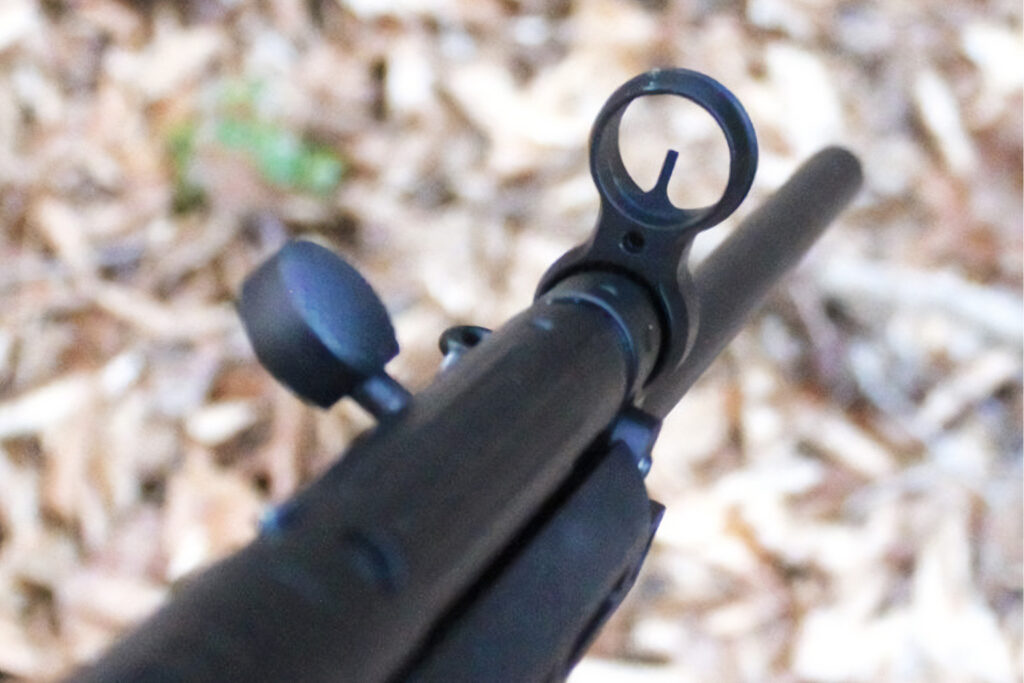
All of the roller locked H&K designed guns are inherently accurate. I have a semi-auto version in 7.62 NATO that shoots ¾ MOA groups. This gun will squeeze all the accuracy possible out of the 9mm Luger cartridge.
Front sight with bolt handle in foreground.
Since this is an American made version and not an original H&K production a logical question would be is the quality the same? The answer is yes. When Portugal adopted the H&K G3 rifle they built it under license under H&K supervision. After the production was finished PTR in the U.S. bought that machinery and brought it to this country where they make semi-auto only versions to the highest quality standards.
One thing they did improve was the H&K trigger. All the PTR guns that I have examined had excellent trigger pulls. Bureaucratic demands for safety in drop tests from insane heights led to many military G3 rifles having poor trigger pulls in order to meet the unrealistic requirements set before them.
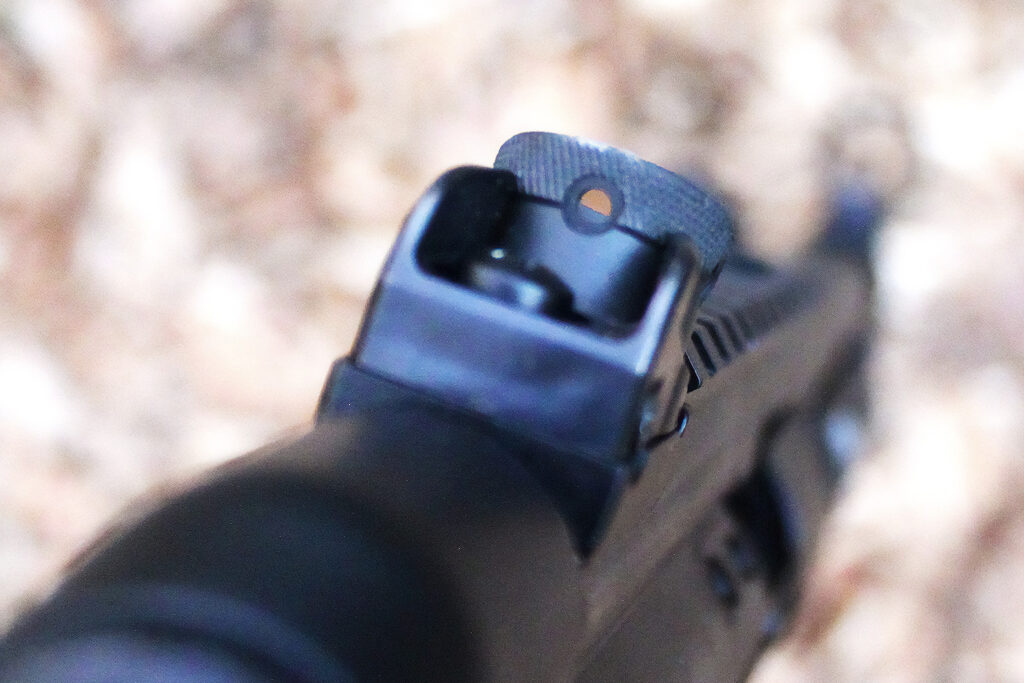
Rear sight is typical of metallic sights used on many European-designed semi-auto rifles and carbines.
As a gun writer I have reviewed guns from all the famous U.S. firearms manufacturers, some of which no longer deserve all of their good reputation for they are riding more on their past glory than their current quality. I rate PTR among the best for consistent quality to the highest standards. Not only that but they are making the most reliable design in production today. The roller locked G3 rifles are second only to the WWII Johnson rifles and light machineguns in reliability and the Johnsons have not been made since WWII. Back when Army Ordnance first got their hands on a roller locked MG42 they were all laughing at “The cheap Kraut machinegun” but when America’s greatest expert on the different types of machinegun mechanisms, Colonel George Chinn, examined it he shocked them all with his assessment.
“The designer of this gun should get a million dollar bonus and Germany’s highest medal,” he said. “We need to adopt this weapon at once!”
The colonel fought tirelessly for the adoption of the MG42 even going so far in his demonstrations as to trickle sand into the locking recesses of the roller lock letting the roller locks act as a hammer mill as the gun fired pounding the sand into silicon lubricant for the rest of the gun. Unfortunately the military’s attitude was best summed up years later when the U.S. and Germany signed a treaty whereby the winner of the tank trials between the new U.S. M1 tank and the German Leopard tank would be adopted by both countries. General Abrams famously said “We’ll adopt a damn Kraut tank over my dead body!” and that was that.
Later when the Navy went to Colonel Chinn to design a new 20mm cannon he incorporated the roller lock system into his design. Today he is best known for designing the 40mm MK19 grenade launcher and his 4 (later 5) volume set of books “The Machinegun” detailing all the different mechanisms designers can use for the various components of machineguns.
As for the MG42, it was long after WWII and the Korean War ended that the U.S. finally adopted a general purpose machinegun, the M60. Unfortunately when deployed in the Viet Nam War the M60 soon proved to be a jam-o-matic that could quickly get it’s operator and the men depending on its firepower killed.
The early M16 was also a disaster. In both cases had the troops had MG42’s and G3 rifles a lot of Americans would still be alive because their guns didn’t jam and a lot of the enemy that are still alive would be dead instead. The 7.62 NATO bullet of the G3 also cut through the thick jungle growth to kill the enemy at the other end while the little 5.56 MM bullet of the M16 was notorious for blowing up and/or deflecting leaving the enemy unscathed and still firing at you. Today both the MG42 and the G3 are still the best guns in their class and both of them far outperform the intermediate caliber guns in the field.
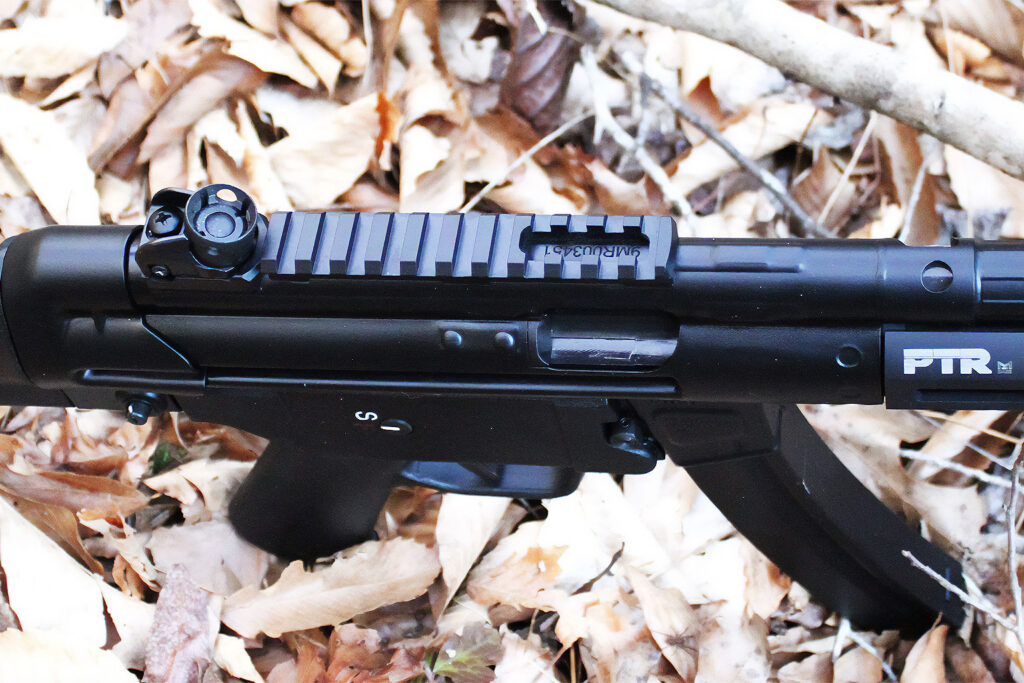
Picatinny-type rail on receiver allows for mounting optical sights.
It’s worth noting that the H&K MP5 SMG has become one of the most popular submachineguns out there despite there being cheaper reliable competitors. Of course, the civilian model is not a sub-gun.
For the civilian version, the 9R, we find a whole host of uses. As a subsistence hunting gun it is a good choice, particularly for small and medium game although it can take on the larger stuff. It is light and easy to carry and unusually easy to hit with for such a light and compact rifle. Compared to a .22LR it is infinitely more humane giving the clean kills that are too often not the case with the .22LR unless shot placement is absolutely perfect. Unfortunately too many folks send their kids afield with a .22LR when the youngsters are not capable of the precision shooting required for clean quick kills. A lot of adults can’t do it also, particularly on running game. That’s why for well over 100 years people have been saying the .22 is inhumane and we should use a .32-20 on game. Well .32-20 is now mostly a memory along with the old high velocity .32-20 rifle loads but a 9MM expanding bullet still gets the job done fast and humane.
Not only is it an efficient killer it is so compact and light that it easily goes anywhere. Small women and children will also appreciate it’s size. My 5-foot 2-inch wife often shot guns that appeared as big as she was but her favorite was a little Ruger .44 Magnum semi-auto carbine that just fit her.
The advantage of having a shoulder arm shooting the same caliber as your pistol is just as great now as it was over 160 years ago. You only have to pack one type of ammunition and you don’t run the risk of running out for one of your guns, as happens when the pistol and rifle are different calibers.

Image courtesy of Black Hills Ammunition shows capability of 9mm penetration.
Most people cannot shoot as well with a pistol as they can with a carbine despite both being in the same caliber. Therefore as a defensive pair a pistol will be found to be the best choice for inside the house gunfighting and the pistol caliber carbine will drastically extend the range if the engagement is outdoors.
When confronting unsavory characters nosing about your goods on your property the formidable SMG appearance of this arm makes it more likely that they will leave without a fight. It’s very presence may sometimes be enough to keep things polite without having to threaten anyone. If not, then you have a very formidable weapon at your side. I would always prefer this to the old traditional farmer’s single barrel shotgun that often accompanied them on their rounds.
The advantage of a virtually recoilless pistol caliber carbine is that it is more like shooting a big .22 than a powerful rifle yet it has plenty of power for most situations. When the coyotes are after the small children or the livestock you have a light handy carbine that can easily hit them at 100 yards or more. Likewise it can also bag squirrels or rabbits for dinner without as much noise as some other carbines.
All of the above is important but we should also remember that this is also a very fun gun to shoot. I had a lot of ammunition for the test. All velocities shown are the factory velocities from pistol barrels.
Here is a roundup:
- 500 rounds of Black Hills 9MM 124 grain jacketed hollowpoint +P at 1,150 fps. This is a perfect hunting load.
- 500 rounds of Black Hills 9MM Honeybadger +P 100-grain at 1250 fps. The Honeybadger is a fantastic all-purpose projectile combining the best of both a solid and an expanding bullet. It is a fluted monolithic solid whose flutes are larger at the front than the back thus focusing all the fluid and tissue through them like the constriction in a garden hose nozzle thereby increasing their velocity by 35%. In technical terms you would say this is because of the large pressure differential between the large fluted regions and the free stream velocity. The spinning nozzle effect of the material passing along the flutes creates a cavitation passage far larger than the deep penetrating solid projectile so you end up with the wound channel of an expanding bullet while retaining the deep penetration of a solid. The best of both worlds.
- 500 rounds of Black Hills 9mm Honeybadger subsonic at 1,000 fps. With the rising popularity of suppressors it makes sense to have loads tailored to these wonderful hearing protectors. Like an automobile muffler they don’t remove all the noise but they sure make it more bearable.
- 400 rounds of Privi Partizan 115-grain 9MM FMJ at 1,145 FPS. This is the old reliable military load with which the 9mm Luger cartridge first made its reputation. Privi Partizan is a Serbian company that has been making quality ammunition since 1927.
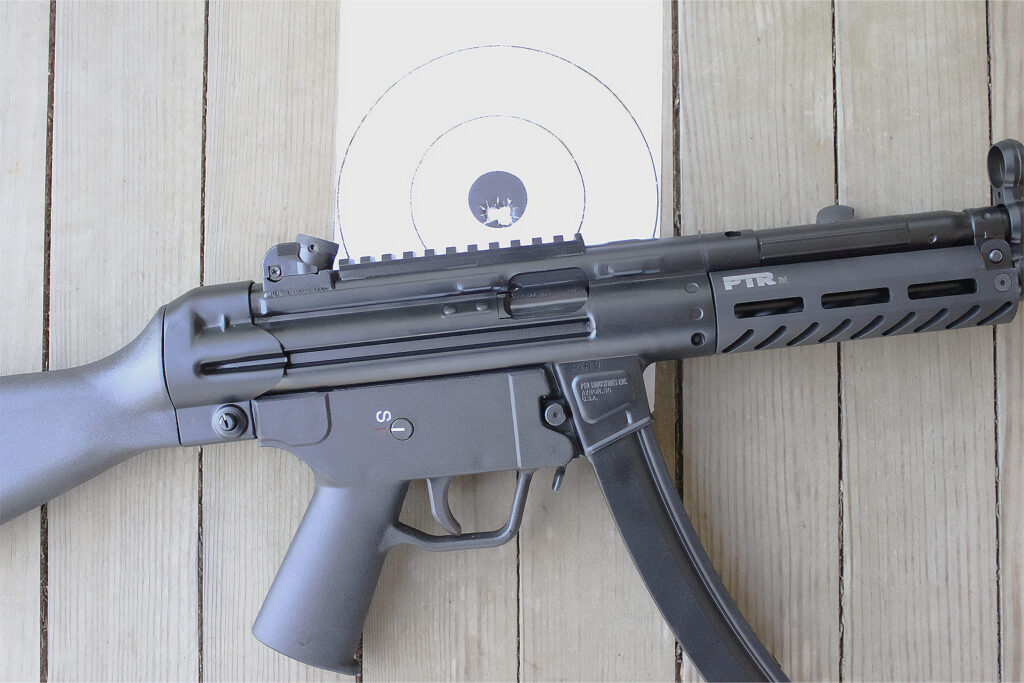
Typical of the accuracy shown by the 9mm PTR, this target tells it all.
Firing the 9R is just plain fun. There is no felt recoil and it’s like shooting a big .22 rifle that is steadier and easier to hit with than most .22’s because of its extra weight and superb handling qualities.
This tack driver is one of the easiest and accurate that I have fired. Every time I review a gun from PTR I hate it when I have to send it back and this little gem is no exception.

